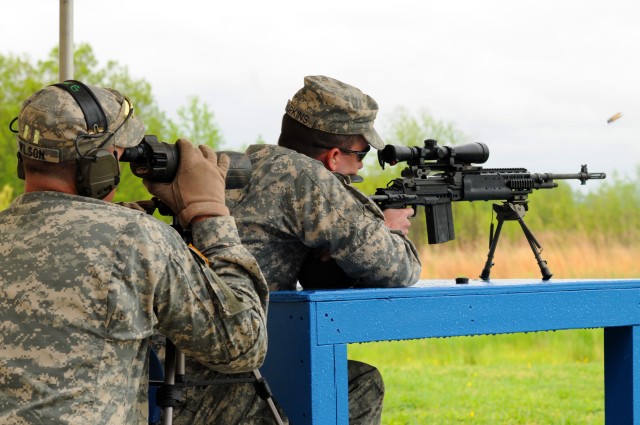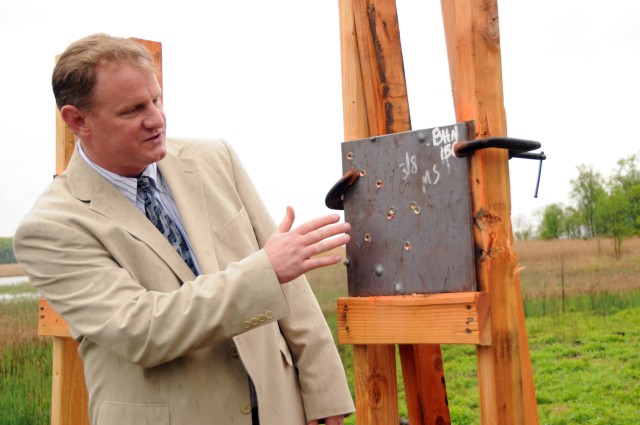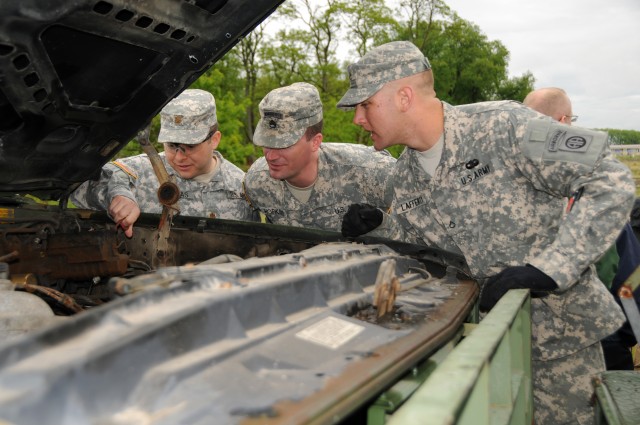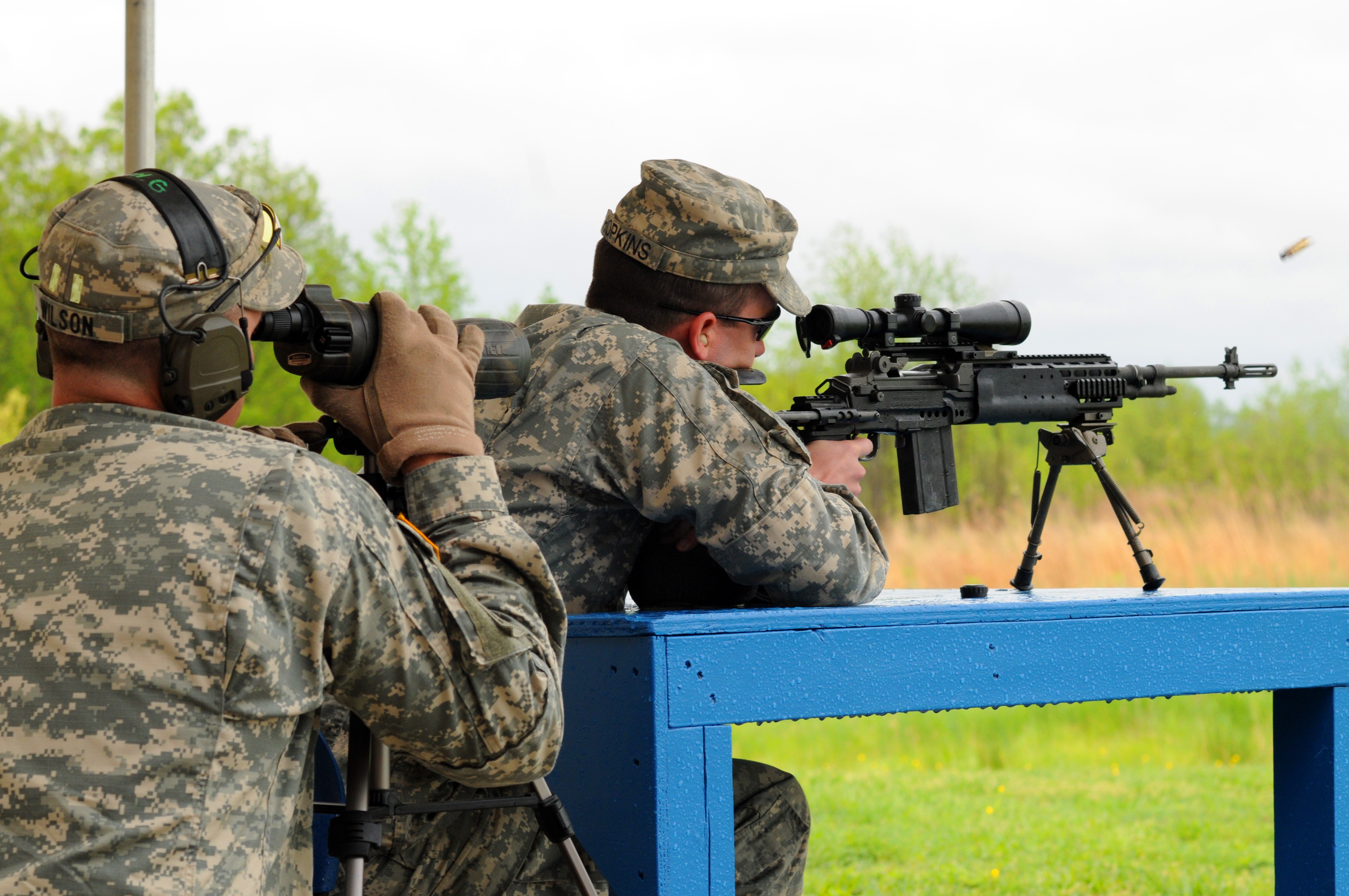ABERDEEN, Md. (Army News Service, May 6, 2011) -- Since June, the Army has fielded about 30 million of its new 5.56mm M855A1 "Enhanced Performance Rounds" in Afghanistan.
The cartridge, sometimes called the "green bullet" because it has an environmentally-friendly copper core instead of the traditional lead, has been getting mostly good reviews in the 11 months since it first deployed to Operation Enduring Freedom.
"The vast majority of everything we've got back from the field is positive," said Lt. Col. Jeffrey K. Woods, product manager, small caliber ammunition, during a "media day" at Aberdeen Proving Ground, Md.
During the day-long event, reporters learned the benefits of the new cartridge, witnessed a demonstration of the round, compared to the round it is designed to replace, and had the opportunity to fire the round from both an M16 and M4 rifle.
Perhaps the biggest plus of the M855A1 "enhanced performance round" is the consistency it brings to the fight -- more so than the 5.56mm M855 round it is designed to replace.
Woods and other officials were reticent to talk specifically about the effects of the new bullet, or any bullet, on a "soft target" -- a euphemism for enemy personnel. But what they made clear was the M855A1 is at least equal to the M855 on a soft target -- but that it did damage with more consistency.
The M855 is a good round, Woods said, but it is "yaw dependant." Like all bullets, it wobbles when it travels along its trajectory. Its effectiveness depends on its yaw angle when it hits a target. Not so with the M855A1. The new Enhanced Performance Round, or EPR, is not yaw-dependant -- it delivers the same effectiveness in a soft target no matter its yaw angle.
"On M855's best day, with that great performance that you will see, you're going to see that type of performance out of the EPR -- but you will see it every time," Woods said.
The EPR cartridge is the same length as the M855 that it's designed to replace, though the bullet it contains is about 1/8 of an inch longer. The weight and shape of the EPR is also the same as the M855, so it fits anything an M855 fits -- including the M16 and the M4 it was designed for.
The bullet itself has been redesigned completely. It features a larger steel "penetrator" on its tip, that is both sharper than what is on the M855 and is also exposed. Both bullets feature a copper jacket, but the EPR's jacket is "reverse drawn" -- part of its manufacturing. Perhaps the most notable feature of the EPR is that its bullet features a copper core, verses the M855's lead core.
There's also a new propellant in the EPR, designed to enhance its performance in the M4 Carbine rifle -- what most Soldiers are carrying today in Afghanistan.
The M4 has a shorter barrel than the M16 rifle, and barrel length is directly related to a bullet's velocity.
"The M855 leaving an M16 had a higher muzzle velocity than when it left the M4," Woods said. "Because the M16 is the longer barrel, you get the full burn of the powder, pushing a bullet to its maximum velocity before it left the barrel."
On an M4, however, the M855 bullet might leave the barrel before its powder is completely burned -- that means the bullet isn't getting the full benefit of all the powder contained in its shell and an increased muzzle flash.
"A longer-burning propellant is still burning when the round is leaving the barrel and you are going to get a brighter flash, which is obviously not good for Soldiers," Woods said.
Both of those issues have been addressed with the M855A1.
The SMP-842 propellant in the EPR burns quicker, ensuring less muzzle flash in the M4, and also meaning improved muzzle velocity.
The performance of the EPR against soft targets is the same as that of the M855 -- but it is more consistent. The new round is also "superior to 7.62mm M80 against soft targets," Woods said. But at the same time the new "green round" is more Earth-friendly than both the M855 and the M80 -- it is also more effective than either of them against hard targets.
A test fire an Aberdeen Proving Ground range pitted the M855A1 round against the M855 and the M80 in multiple weapons -- the two 5.56mm rounds were fired in both the M4 and the M16, and the 7.62 M80 round was fired in an M14 Enhanced Battle Rifle. All three rounds are use today.
In all test firings against a sheet of 3/8-inch mild steel plate at 300 meters, the M855A1 came out on top.
Test center video also showed the EPR to be equally superior against concrete masonry units -- similar to cinder block. The M855A1 was able to penetrate such a block up to about 75 meters with the M16, and up to about 50 meters with the M4. The M855 was unable to penetrate the blocks at those ranges.
Wood said Soldiers have been told to turn in M855 cartridges and switch now to EPR. In February, he said, was the first time there's been more expenditure in theater with the EPR than with the M855.
The round is effective, Woods said, and testing at Aberdeen has shown that to be true -- against realistic testing targets. But the round can't be effective against enemy combatants unless Soldiers use it in their weapons -- and they need to trust that it works before they will want to use it.
Staff Sgt. Jason Hopkins, of the Maneuvers Center of Excellence, Fort Benning, Ga., has served four years in Afghanistan and two years in Iraq. He's seen combat, and confirms that while there he's used his weapon against "soft targets." He was one of the Soldiers at Aberdeen who test fired the new round -- and says he's convinced.
"We were a little skeptical -- like any change in the military, a little skeptical," Hopkins said of the EPR. "But coming up here and shooting it and seeing the performance of it -- I'm sold on it. The trajectory and the ballistics are just as good as the M855 and the penetration is far superior to the M855."
"It looks like just a more consistent round," he continued. "With the M855 you may not always get the same thing -- but everything we've seen with this EPR has been dead consistent every time."
As far as the new round's accuracy, Hopkins said, "It's on par if not better."
Woods said testing shows the EPR does produce a tighter shot group -- by about 2 inches at 600 meters.
As far as "stopping power" of the new round, Hopkins clarified what that term means to him -- and confirmed his faith that the round would do its job when he might be required to use it.
"Stopping power is incapacitation of a target so he cannot engage me or continue his mission," Hopkins said. "I haven't used the EPR in that situation yet, but I've used the M855. It's been effective. It's an effective round. But I truly believe the M855A1 will be more consistent."
Pvt. 1st Class Scott Lafferty, 1st Brigade, 82nd Airborne Division, has served once in Iraq. He was also a tester at Aberdeen. When he talks to other Soldiers about the effectiveness of the round, he said he's going to tell them what he learned during his test experience.
"I'm going to tell them how we've shot both different kinds of rounds and how the M855A1 is superior and they can test for themselves and find out," Lafferty said. He said that a weapon's effectiveness is largely dependent on a Soldier's training, but added, "I am confident the bullet will do what I've seen here today, and yesterday."
Related Links:
STAND-TO!: Secretary of the Army Environmental Awards Program








Social Sharing